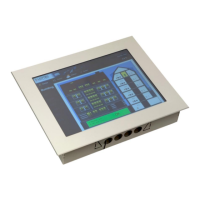L-VIS User Manual 275 LOYTEC
Version 6.2 LOYTEC electronics GmbH
device would no longer be usable together with older management software, which does
not provide support for the extended command set.
To guarantee that the device will be usable together with older tools, the Network Settings
dialog, which is accessible from the File menu, has a checkbox to enable a so called
CEA-709.1-A restricted mode. In this mode, the device will not accept any of the extended
commands and react according to the old standard. This also means that the device is
limited to 15 address table entries.
13.5 Feedback Data Points
Feedback data points allow reading back the value written out over an output data point. In
LONMARK systems, getting a feedback value is normally accomplished by creating a
dedicated feedback NV on the remote device which can be bound back to the devices that
are interested in the currently active value. This is especially important if multiple
independent devices write to the same input of one device, since none of the writers may
assume that the value he last wrote is still in effect.
Some nodes, however, do not possess such feedback NVs for certain functions. To support
getting feedback values on such nodes, it is possible to create feedback data points based on
existing output data points. This is especially interesting for bound output NVs (static and
dynamic alike). The corresponding feedback data point is an input, which uses the original
output NV for polling the target NV. In case the binding is changed, the new target is polled
automatically. No additional input NV needs to be created for the feedback value, if the
feedback data point feature is used.
To Create a Feedback Data Point
1. Select an output data point in the data point list of the CEA-709 Port folder, e.g.
‘nvoHumid101’.
2. Right-click and choose Create Feedback-Point from the context menu.
3. A new input data point is created, having ‘_fb’ appended to the original name, e.g.,
‘nvoHumid101_fb’. Note, that the feedback data point maps to the same NV index as
the original output data point.
4. Choose an appropriate poll cycle in the data point properties for the feedback data
point.
13.6 Configuration Properties
Configuration properties (CPs) are supported by the LNS network scan and the online
network scan. They can be selected and used on the device in a similar way as NVs. There
is a notable difference to NVs: CPs are part of files on the remote nodes. Reading and
writing CPs on the device results in a file transfer.
The device supports both, the LONMARK file transfer and the simpler direct memory
read/write method. In both cases however, one has to keep in mind that a file transfer incurs
more overhead than a simple NV read/write. Therefore, polling CPs should be done at a
much slower rate than polling NVs (e.g., every 10 minutes).
Another aspect is how CPs are handled by network management tools. Formerly, those
tools were the only instance that could modify CPs in devices. Therefore, most tools do not
automatically read back CPs from the devices when browsing them. This can result in
inconsistencies between the actual CP contents on the device and their copy in the network

